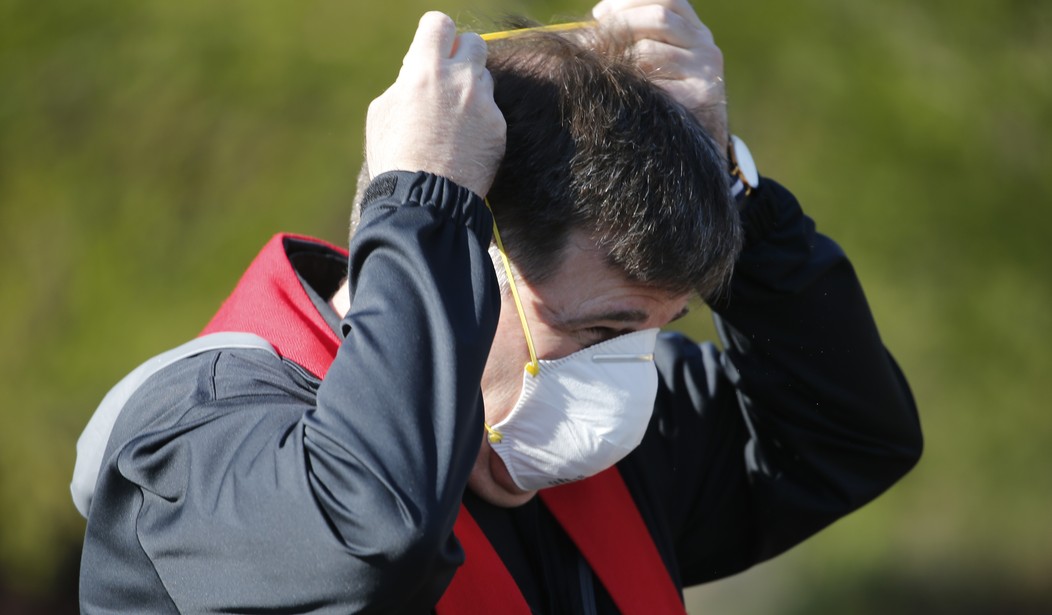New York, New Jersey, Maryland, and other states are requiring everyone to wear a mask or a substitute face covering to leave home. The federal Centers for Disease Control and Prevention has suddenly flipped from urging the public not to wear masks to recommending that they wear something that covers their nose and mouth.
New York's Mayor Bill de Blasio's new signature look is a western-style bandana pulled up over his mouth and nose. No doubt he's well-intentioned. But that kind of face-covering is only a hair better than no covering at all. Science shows it's a mere 2% to 3% effective. It's misleading.
From Day One of the coronavirus outbreak, the public has gotten the run around about masks. Government officials need to be honest about what works and what doesn't. Here's the scientific evidence:
N95 masks, which are molded and fit tight to the face, filter out 95% of viral particles, even the smallest ones. These masks offer the best protection, but they are in short supply, and public officials want them reserved for health care workers on the front lines.
Surgical masks, the kind you see commonly worn in hospitals and dentists' offices, are flat and held to the face with elastic. They're made from a nonwoven material, polypropylene, that is a somewhat effective filter. They protect the wearer from about 56% of viral droplets emitted by an infected person nearby, according to research in the British Medical Journal.
Not so woven cloth masks. They allow in 97% of viral particles. That means almost no protection for the wearer.
Recommended
Wearing a homemade cotton mask is a false assurance, explains epidemiologist May Chu. She says it will block only about 2% of airflow. Similarly, a study in Disaster Medical and Public Health Preparedness concludes that a homemade mask should be considered "only as a last resort," better than no protection at all but not a lot better.
Surgical masks seem available in stores now, and if you can buy a supply, using them is far preferable to make your own. Don't reuse the mask and avoid touching the outside of the mask, because it's likely contaminated after use.
If you have to resort to homemade barriers, keep in mind that the more layers of cloth, the better the protection. Four layers likely block out 13% of viral droplets, compared with the 2% blocked with a single layer, according to a study in Aerosol and Air Quality Research.
Why are public officials suddenly urging mask use, many weeks after the coronavirus struck? Because of mounting research pointing to the huge role of asymptomatic people spreading the disease before they feel ill. Whenever these asymptomatic carriers talk or simply exhale, they spread very small droplets of virus-laden saliva and respiratory mucous in the air. Scientists call it bioaerosols.
Getting everyone to mask up does double duty -- helping to protect the uninfected and keeping the unknowingly infected from spreading the virus. As New York Governor Andrew Cuomo said, announcing the mask mandate: "You don't have a right to infect me."
That makes sense, but Americans have had to put up with a lot of message confusion from the outset, and now they're getting misleading advice about homemade masks.
What's the root problem? Year after year after year, through three presidencies, federal health bureaucrats ignored warnings about inadequate supplies of masks and other equipment in the event of a pandemic. Ten federal reports sounded the alarm, even as the nation witnessed SARS, MERS, avian flu and swine flu that circled the globe. In 2009, during the swine flu outbreak, the federal Strategic National Stockpile dispersed 85 million N95 masks, as well as other protective masks. The masks were never replaced.
Don't blame any president, Democratic or Republican, for this oversight. The career officials at Health and Human Services knowingly allowed the nation to be undersupplied. They never requested enough money to adequately stock the Strategic National Stockpile. Their agenda was global, tracking down polio in Pakistan, pouring nearly $5 billion in the fight against Ebola overseas and funding a Global Health Security Agenda serving 49 countries. But no masks for Americans.
When the coronavirus struck, the CDC offered only mask double talk. The agency said, on the one hand, masks are vital to protect health care workers, and on the other hand, masks won't make the public safer. It defies common sense. The agency should have leveled with people, admitting supplies had to be saved for front line caregivers.
The coronavirus could return next winter. Or another viral pandemic could strike from any part of the globe. The bill Congress enacted in late March allocates $16 billion to the Strategic National Stockpile, nearly 30 times its annual budget. Next time, the U.S. will have enough masks.

























Join the conversation as a VIP Member